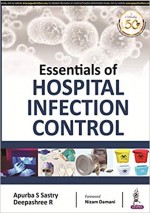Om Publications

Essentials of Hospital Infection Control
ApurbaS Sastry and Deepashree R
₹1074 ₹1095 (2% off)
ISBN 13
9789352706907
Year
2019
Contents: 1. Introduction to Healthcare-associated Infections. 2. Structural Organization of an Infection Control Program. 3. Major Healthcare-associated Infection Types. 4. Surveillance of Healthcare-associated Infections. 5. Standard Precautions-I: Hand Hygiene. 6. Standard Precautions-II: Personal Protective Equipment. 7. Transmission-based Precautions. 8. Infection Control in Special Situations. 9. Disinfection Policy. 10. Central Sterile Supply Department. 11. Environmental Surveillance. 12. Screening for Multidrug-resistant Organisms. 13. Infection Control in Laundry. 14. Infection Control in Kitchen and Food Safety. 15. Waste Management in Healthcare Facility. 16. Staff Health Issues-I: Needle Stick Injury Management. 17. Staff Health Issues-II: Work Restriction and Vaccination. 18. Outbreak Investigation. 19. Antimicrobial Stewardship. 20. Infection Control Requirements for Accreditation. Index.
Infection Control is an essential component of any healthcare delivery system. In the light of paucity of quality book on infection control in India, Essentials of Hospital Infection Control will serve as a platform to guide the medical professionals in mastering infection control.
Key Features:
• Organization of infection control program in Indian context included.
• Major HAI types such as CAUTI, CRBSI, VAP and 551 covered; giving insight into pathogenesis, laboratory diagnosis, treatment and prevention.
• HAI surveillance elaborated according to patient safety component manual, NHSN-CDC 2019; covering common terminologies, surveillances of CAUTI, CLABSI, VAE (including latest concept of PedVAE) and 551, and data collection and analysis. Step-by-step illustrations and numerous problem solving exercises included for better understanding of the concept.
• Standard precautions such as hand hygiene, personal protective equipment along with detailed elaboration on transmission based precaution included.
• Infection control in special situations or infection type such as transplant units, dialysis units, ICUs, operation theater and outpatient department, autopsy, infection with C. difficile, M. tuberculosis, viral hemorrhagic fever, Legionel/a, etc. included.
• Disinfection policy covering various areas such as Spaulding's classification of devices and HiTouch areas disinfection, housekeeping policy, endoscopy reprocessing, spillage management, reuse of single use device and disinfectant testing.
• Environmental surveillance (air, water and surface including endotoxin detection method) and screening for MDROs included.
• Infection control policy at CSSD (including sterilization indicators), laundry and kitchen included.
• Biomedical Waste Management covered according to 2016 guidelines with inclusion of 2018 amendment.
• Infection control requirement for NABH accreditation included.
• Staff health issues included-needle stick injury (NSI), work restriction and immunization for healthcare professionals including CDC strategies for hepatitis B vaccination.
• Outbreak investigation included.
• Antimicrobial Stewardship Programme (AMSP) covering strategies of AMSP, role of laboratory stewardship, antimicrobial policy and monitoring of AMSP.